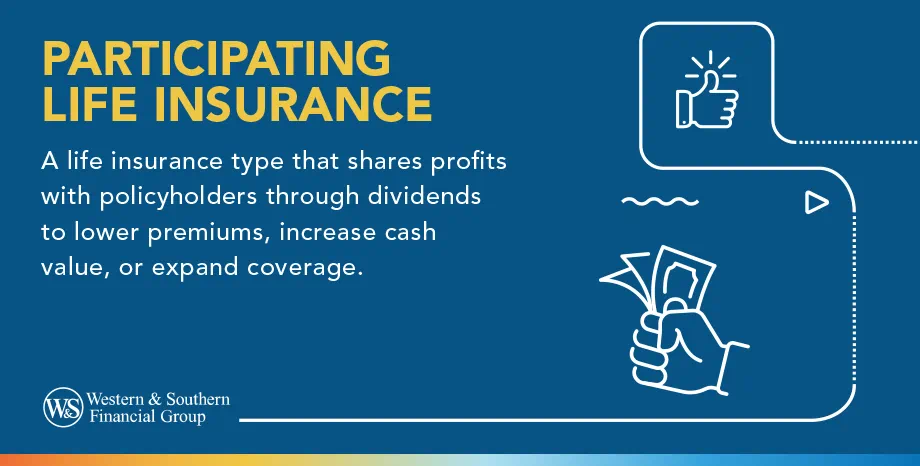

Key Takeaways
- Participating life insurance policies are those that return profits to the policyholder in the form of annual dividends.
- Dividend-paying whole life policies are issued by mutual companies, which are owned by policyholders.
- When comparing policies, the company's record of paying dividends is something you should consider.
- Participating policies are often more expensive than others but may provide higher returns.
Permanent life insurance is a versatile financial product that helps protect your family while building cash value. However, not all permanent life insurance contracts work in quite the same way.
Participating life insurance, for example, may provide additional returns on your policy's cash value. The longer you own the policy, the more valuable this feature can become.
What Is a Participating Life Insurance Policy?
Participating life insurance is a product that involves the insurer sharing its profits (if any) with policyholders in the form of either a dividend or a bonus. Such payments are typically made once per year and are not guaranteed.
While some insurers may pay relatively consistent dividends for many years, the size of those payments — and whether they are made at all — ultimately comes down to the company's financial performance. If an insurer lacks sufficient earnings to draw from, then it may not distribute dividends or bonuses that year.
Not all life insurance companies offer participating policies. Those that do are organized as "mutual" insurance companies. That means they are not owned by shareholders. Their goal is to return profits to their customers through dividend payments, lower premiums or a combination of the two. They contrast with "stock" insurance companies, which are owned by outside investors and which don't pay dividends to policyholders.
Even among mutual companies, however, not every permanent life insurance product "participates" in company profits. Typically, the only products eligible for dividends and bonuses are participating whole life insurance policies. Term life insurance, for example, doesn't have a cash value and thus doesn't credit dividends.
Before purchasing life insurance coverage, make sure you understand whether it's a participating or non-participating policy. While it doesn't guarantee future payments, you may want to research how consistently the company has paid dividends over the years. That track record can be an important window into the company's financial strength and the performance of its management team over time.
How Do Participating Life Insurance Policies Work?
Now you might be wondering: "How does a participating life insurance policy work?" Beyond providing guaranteed death benefit protection, whole life insurance policies allow you to build cash value as you pay your premiums. The insurer credits your cash balance with a fixed interest rate based on conservative assumptions about its investment returns and mortality expenses. Companies offering participating whole life policies expect to have enough profit left over after crediting that guaranteed interest to pay out a dividend, as well.
This additional distribution is not guaranteed. The amount may change from year to year based on the company's financial performance. Its amount of profit — and, thus, the size of its dividend payout — depends on certain factors. These include:
- Investment performance. Insurers must be cautious when estimating the returns they'll receive from invested assets. If their investments provide a return beyond what's projected, however, they may add it to their dividend payout.
- Mortality risk. Life insurance companies use actuarial data to predict how much they'll have to pay out in death benefit claims during a given year. Should actual mortality expense end up being less than assumed, they're more likely to generate a profit.
- Operational expenses. All insurers incur a variety of expenses to keep the business going, from paying salaries and rent to marketing costs. The better the company is at minimizing those outlays, the better its chances of earning a profit and being able to pay a significant dividend.
At the end of the year, mutual insurance companies will often announce the total dividend they intend to distribute to policyholders. The amount of the dividend you receive depends on your guaranteed cash value at the end of the year. The issuer will multiply this cash value, minus any fees, by the rate they've calculated based on the overall dividend.
As an example, Jane has $100,000 in cash value at the end of the year, and her policy guarantees a 3% annual interest rate. It also declares a 2% dividend payment based on its financial performance during the past year. In addition to crediting Jane's account $3,000 interest ($100,000 x 0.03), Jane is eligible for $2,000 in dividends ($100,000 x 0.02).
How You Can Use Your Dividend Payment
If you have a participating policy that pays a dividend, you have several ways you can receive your dividend payment. These may include:
- Cash. The simplest choice is often to receive the non-guaranteed dividend payment in cash, which is generally tax-free. The insurer will usually offer to send the distribution via check or a direct transfer to your bank account. If you don't need the money right away, you can choose to deposit it into an interest-bearing account or an investment account.
- A premium reduction. In most cases, the insurer will let you apply the dividend to your premium payment. Doing so allows you to keep the policy active while reducing the amount you pay each month. In effect, the amount of premium you pay out of pocket may go down over time.
- Accumulate at interest. You can leave the dividend in the policy, where it adds to your cash value and continues to accrue interest. With a whole life policy, you typically receive a fairly conservative return on your money, but the rate is guaranteed.
- Buy additional insurance. You can also use the dividend to buy "paid-up additions." Essentially, you're increasing the amount of the death benefit associated with your policy, providing added financial security to your beneficiaries. Because you're using dividends to pay for that additional coverage, your premium does not increase.
- Pay down policy loans. If you've borrowed against your policy, some insurers may allow you to repay part or all of that amount with your annual dividend disbursement. There are numerous benefits to chipping away at your loan balance, including the ability to reduce or eliminate your interest payments to the insurance company. You can also help protect your beneficiaries, as outstanding loans reduce the death benefit they otherwise would receive from your policy.
Participating vs. Non-participating Life Insurance
Participating and non-participating life insurance policies are fundamentally different in how they allocate profits. Participating policies return part of the profit they earn to you through dividends, which can significantly increase your asset growth — especially if you use that money to buy additional coverage or move it into a separate investment account. Given the impact of compound returns over time, those dividend distributions can make a big impact on your financial well-being in the long run.
With non-participating policies, the insurer retains any profits it generates. If the company is publicly traded, it may return some of those earnings to shareholders, but not policyholders, through dividend payments.
Non-dividend-paying policies still offer a guaranteed death benefit that will go to your beneficiaries when you pass, provided you pay the required premiums to keep the protection in force. They also pay a guaranteed interest rate on your cash value, but lack the potential to credit an additional amount on top of your guaranteed interest amount.
Because of this potential cost for the company, participating policies are usually more expensive than non-participating ones. However, the potential to receive additional income every year may outweigh that difference.
Learn the benefits of Participating Life Insurance today. Get a Life Insurance Quote
Pros: Benefits of Participating Life Insurance
All whole life insurance products allow you to grow cash value while guaranteeing a death benefit that will help safeguard your loved ones. However, participating whole life policies offer some unique advantages over non-dividend-paying policies, such as:
- Potential for larger returns. There's no certainty that your insurance company will return profits to policyholders in a given year. That said, buying from a carrier with a consistent track record of paying dividends can provide confidence you'll earn more than the guaranteed interest rate.
- Tax-free income. Dividends that you receive through your life insurance company typically aren't subject to taxes unless they exceed your total payments into the policy. That's not the case with dividends paid to shareholders of a publicly traded company, where dividends are generally taxable.
- Flexibility. You can use your dividend distribution in various ways, whether you decide to spend it, pay down premiums or buy more coverage. You can make adjustments to how you allocate that money based on your evolving financial needs.
Cons: Drawbacks of Participating Life Insurance
Because participating whole life policies generally come with slightly higher premiums than policies that don't pay dividends, cost is a factor to consider when determining your coverage. Over the long haul, that pricing difference may prove worthwhile if you receive consistent dividends. But should you become unable to make your premium payments before you've accumulated significant cash value, you may have to forfeit your policy and even incur surrender charges.
In general, permanent life insurance is more complex than term life insurance, which is less expensive but lacks a cash value component. Those looking for a more basic life insurance solution may want to consider term protection and invest the amount saved in a separate account.
Who Should Consider a Participating Life Insurance Policy?
These types of policies may be a good fit if you seek lifelong coverage that will protect your spouse, children or other dependents for as long as you pay the premiums. Because participating whole life insurance is permanent, you don't have to worry about your policy expiring at a fixed date and risk having to satisfy medical underwriting to obtain new coverage.
In addition, participating policies may be an attractive option if you're looking for a way to grow your assets while reducing your tax liability. Dividend distributions are generally tax-free to policyholders, as are policy withdrawals and loans — up to the amount you've paid into the policy. That feature is especially beneficial if you're in a higher tax bracket or you've maxed out contributions to tax-advantaged retirement accounts.
Lastly, affordability should be a key consideration when deciding which type of life insurance to purchase. Whole life protection is usually more expensive than term insurance, and you'll likely pay even more if you buy a dividend-paying policy. Participating whole life is only a sound option if you're confident you can pay the premiums going forward.
Is a Participating Life Insurance Policy Right for You?
Participating life insurance policies allow you to benefit from the company's success with non-guaranteed dividends. Those additional payments give you added financial flexibility, since you can receive the disbursement in cash, pay down your premium or even buy additional coverage.
However, the potential to receive dividends shouldn't be the only factor when deciding which type of life insurance to buy. You should research the company's financial strength, claims-paying history and pricing before making your choice. A financial professional can help you better understand the pros and cons of participating policies and make sure you consider the right amount of coverage for your needs.
Search how a Participating Life Insurance Policy can work for you. Get a Life Insurance Quote


































